 This work is licensed under a
Creative Commons Attribution-NonCommercial-ShareAlike 2.5 License.
This work is licensed under a
Creative Commons Attribution-NonCommercial-ShareAlike 2.5 License.
nectar sources in West Cornwall
Honey comes mostly from the nectar of wild flowers of the trees, hills, valleys and hedgerows, though for some, it comes from cliff-sides, gardens and derelict land. It varies considerably in flavour and texture as between hive locations, time of year and from year to year in the same location. It is always rich and full of flavour and well sought after in the shops by locals and visitors alike. Sometimes there is the orangey tang of a small proportion of honeydew in the late summer crop which adds to the interest.
There is almost no agricultural forage for bees in West Cornwall, except when broccoli is left to flower. In other parts of the country, even further to the east in Cornwall itself, oilseed rape may well be the primary source of honey. The position of clover is variable, many farmers using mono-culture ryegrass. Smaller farmers often encourage clover by non-use of fertilizer and take advantage of the natural help clover gives to the grasses by its nitrogen fixing bacteria. The resulting meadows, may also have a good range of annual and perennial flowers suitable for bees.
honey surplus
Sometimes the spring surplus can be harvested there and then and if left to the more usual harvest time of August (or September where heather flow is major) shows itself as a rich, dark honey which contrasts with the light, thin, bramble-rich summer honey. In some years, hawthorn honey fills one or two supers (about 30-60lb or 12-24kg) from the abundant and sweet smelling May blossom. This is a light, more viscous honey. Some years, June and even July is so poor, that the bees eat their spring stores. Some may even need some sugar syrup to rescue them. Occasionally, summer is so poor there is no excess. A well managed colony will go into the winter strong, with few varroa and associated viruses, build up quickly in spring and store anything up to 75lb of spring honey, followed by up to 150lb summer honey (all in a very good year). More commonly, the typical hive will yield 100-150lb if managed well in a good year, 50-75lb in an average year and 25lb or less in a poor year. All colonies must be left with 30-40lb of honey and pollen to survive the winter and early spring. Harvests are surplus to this basic requirement, though colonies can be topped up with strong sugar syrup in autumn or fed in late winter and early spring to make up any deficit. Our practice is to encourage breeding from colonies which store honey in the brood chamber so as not to need feeding for the winter.
hive types
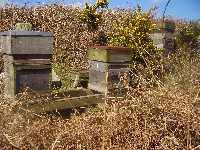
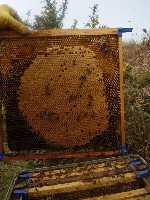
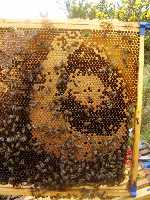
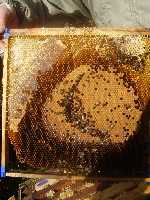
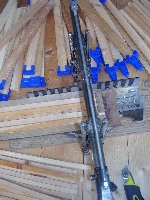
All our hives are all either British Standard National (or a plywood design close to this standard) which take 11-12 frames 14" by 8½" or a large variant which take a 14" square frame. These latter hives do better on average than their BS counterparts, owing to the deep oval shape of the brood nest. This conserves heat, and means that more brood can be reared when it is cool in spring (and later!) since fewer bees are needed to maintain the necessary 35°C. Supers take 10-12 14" by 5½" shallow frames, which means that full supers can be lifted without a crane. All hives are fitted with a simple mesh floor and removable tray underneath so that the natural fall of varroa can be examined, collected, counted and examined in more detail. All trays are cleaned at least every second visit and at least 2-weekly during the brood rearing season. Samples are taken in spring; in summer; before, during and after any treatment to kill varroa; in autumn and winter where feasible or an estimate of the number of fallen mites is made.
colony management
All hives are managed intensively, based on a regular inspection. An quick early look on a warm day in February determines if the colony is normally healthy and the queen has space to lay. Some stimulation in late February or early March with a weak sugar syrup, encourages a more active egg laying, since the syrup mimics a nectar flow. Our bees react to nectar income by producing new bees as well as storing it. Along with any nectar there will also be pollen, without which no brood can be reared.
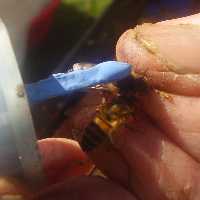
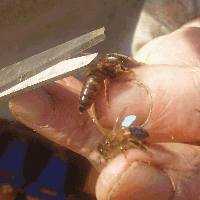
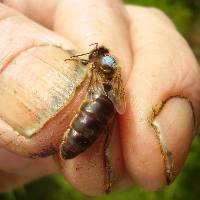 By early April, all colonies are on a weekly inspection schedule and all new queens (from the previous season) are marked as they bare discovered and a wing clipped to prevent her swarming away in between management visits. Weekly inspections continue in an unswarmed stock until early July, from which time few colonies (if sensible!!) will swarm. Frames of comb and stores on the outside of the hive are exchanged for frames with foundation (new wax sheets embossed with the cell pattern) so the bees draw new comb; thus all combs are renewed every 3 years (occasionally 4).
By early April, all colonies are on a weekly inspection schedule and all new queens (from the previous season) are marked as they bare discovered and a wing clipped to prevent her swarming away in between management visits. Weekly inspections continue in an unswarmed stock until early July, from which time few colonies (if sensible!!) will swarm. Frames of comb and stores on the outside of the hive are exchanged for frames with foundation (new wax sheets embossed with the cell pattern) so the bees draw new comb; thus all combs are renewed every 3 years (occasionally 4).
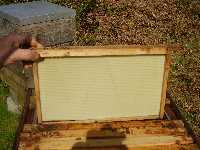
Spring feeding and early comb change will assist the colony to build quickly. Continued feeding can be used to deliberately induce swarming. However, all colonies are managed so they do not swarm (though occasionally colonies do so, either because they do not read the bee books (!) or they swarm in July when they are not being examined!). The best colonies are used to produce new queens. As an experiment in 2006, one apiary was selected to have all inferior queens replaced with a queen cell from a breeding programme in that apiary, inducing simple supersedure with a potentially better strain, though mating from that location might lessen their superiority. However, this approach and that of mating a selected queen (from a different apiary) in the apiary it is moved to, helps maintain the local genetic diversity, which has developed at least as long as we (humans) have been living here, albeit diluted by imports.
their queens or my queens?
When queen cells are noticed, the colony is preparing to reproduce by swarming. This might be fine for bees in the wild without varroa or able to survive even with varroa, but not for managed colonies where honey production is desired and where varroa kills unmanaged colonies within about 2 years. One or other method of swarm control which keeps the bees' process of making queens going but without swarming is selected according to the point in the season. Swarming colonies are split so they start afresh and the cells they have made are replaced with cells from our selected breeders. We rarely cull queen cells but aim to work with the bees' process. The end result should be one honey production colony and one or more new queens with small colonies, depending on the method.
requeening colonies
Once proven, these new queens are used in autumn to replace poorer queens and thus requeen hives. The favoured method is to take a nucleus with the old queen and replace her next day with the new queen and her nucleus. This way, the new strain takes over the old hive and the old queen is kept in reserve. Alternatively, replacements can be made in spring, first to replace failed colonies and second to replace poorer queens. These are the most reliable times to use this method. It is not our practice to replace queens simply to increase production as some commercial beekeepers do, some twice in a year, since we wish to find queens whose colonies show varroa tolerance over their lifetimes. Important characters may only show up consistently over the usual 3 season life of a queen.
useful links
Finding, marking and clipping queens on Dave Cushman's web site, a useful article for beekeepers wanting to take that important step